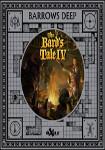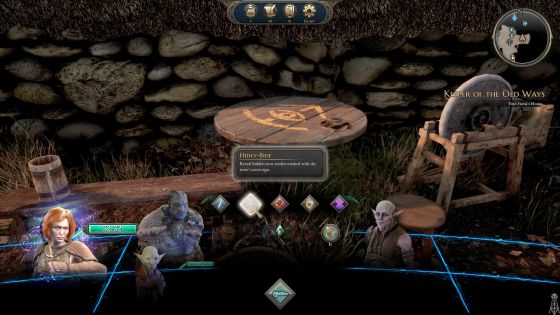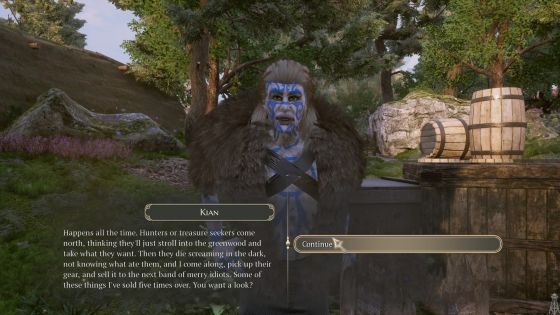Why I won't be finishing The Bard's Tale IV
This isn't a review, so I won't approach it as I normally approach a review. I'm no longer sure it's appropriate to review a game after finishing about 1/3 of it, unless it contains the same content repeated again and again. The Bard's Tale IV isn't that kind of game. It's not procedurally generated but is a hand-crafted game with many different areas, and it introduces new content each time the player enters a new area. I tend to review games I finish, which is why as one of my readers complained I tend to give "good" or "very good" reviews. I actually finish most games I play, but there is a decent minority of games I don't. Those fall into two categories. The first are the games I give 4-5 hours to before I realize I just can't be bothered with and the latter are the long games, like The Bard's Tale 4 IV, that are fun enough to continue with, but at some point are just no longer appealing when I have many other games in my backlog. I started after about 15 hours thinking about abandoning my The Bard's Tale IV game but came back to the game a couple of times before actually quitting, so I actually played 20 hours before throwing in the towel.
The Bard's Tale IV's Ambition: Its Charm and Its Downfall
The Bard's Tale IV is an ambitious game. The original games were dungeon crawlers, with the focus on combat and leveling up your party, with some cool puzzles and traps thrown in, and the occasional story snippet. The Bard's Tale IV offers a full-blown story with quests, companions, and lore. There are secrets, traps, and many, many puzzles. There is also, of course, combat and character advancement. It's a game with authentic Scottish musicians, and fully voiced characters. In short, it tries to do a lot with its limited budget. I find it admirable to try to excel in so many areas. I find if you're going to fail, it's better to fail ambitiously than to fail be being forgettable and nondescript.
The Bard (a live actor) effectively narrates the whole story in loading screens. Just one example of the importance of sound in The Bard's Tale IV.
The Bard's Tale IV does succeed in some areas. Its biggest success is in the area of sound. Sound is an afterthought in a lot of games. I'll also freely admit that I can turn off the sound in games and still enjoy a game for its gameplay or story. I think if sound is important to you in a game, then you probably should play some The Bard's Tale IV just to see what the game accomplishes here. The voice acting, performed by Scottish actors, is genuinely good, as is the quality of the music, and Scottish folk music isn't what I prefer to listen to. The game also features bard songs. You use these songs to solve environmental problems. One songs blasts through weak walls, another rebuilds stone structures, another lets you talk to dead spirits, and yet another reveals hidden stashes of treasure. It's a typical element in The Bard's Tale IV, that you will come across areas that you can't access, and which you can return to later with the right song in order to open up a whole new area. Also, a number of the game's many riddles are sound oriented. Magic mouths will also address you upon your approach, chanting out their riddles.
This Bard Song lets you find hidden stashes. The symbol on the table indicates hidden treasure is nearby.
The Bard's Tale IV's core systems, namely its puzzles and its combat work well. The puzzles are for the most part logical. You learn how to solve a puzzle, such as getting a fairy to fly to a patch of mushrooms. First you learn to turn a totem with 4 faces. Choose the correct face and the fairy flies where you want. Then you encounter the same type of puzzle again, but its more complicated. Soon you are faced with guiding multiple fairies or turning six totems to advance.
Also combat works fairly well, and as I understand it was built around card game mechanics. Your party starts with two characters, but you have 4 actions (called opportunites). Each character has four skills and one piece of equipment they can use in combat, so its like having 10 cards you can play in combat, but you can only choose and play 4. When I quit I had 5 characters in my party (so like 25 cards) and my practitioner could summon a wraith who had 2 more abilities, so I had the possibility of 27 actions, but it's actually more complicated than that, as some actions required preparation, and because moving characters also require a point of opportunity. When you only have 4 actions, you really consider what the best course of action is, especially since like its predecessors, you simply can't save anytime you want in The Bard's Tale IV, meaning that losing combat can erase a fair bit of progress. So you have to be careful who you fight, what you equip and how you fight, because lack of caution and perception can be brutally punished.
Using the posts nearby one has to guide the fairy (the ball of light) to the glowing mushrooms (behind the post) which is more challenging then it looks, especially when you have mutiple totems.
The game also features an impressive crafting system. A large part of the loot you find are crafting materials. You can also find or buy a number of crafting recipes from inns. These let you make food, which you can use to heal outside of combat, potions and talismans that can be used in combat. There is no healing skill and only a limited amount of buff skills, so potions are actually pretty useful to have in tough battles. Also, you'll need alcohol for your bard to sing bard songs. Lockpicks and grappling hooks, which are important for accessing new areas and finding treasures, can also be crafted. Many things, like poisons, potions, and talismans can only be crafted buy spending a skill point on the appropriate crafting skill. The crafting system is in general easy to understand, but useful and deep. Especially when brewing potions you'll need to make some choices about how best to use your resources.
In most other aspects The Bard's Tale IV's successes are limited at best. Let's take its story and characters for example. You've got great voice actors, so you should give them something memorable to say, right? The Bard's Tale IV goes the humorous route, which is a tough route to go, as jokes are hard to pull off. There are a few that made me smile though, like when a Fichti priestess told my group they'd have to impress her goddess, and my trow thief muttered he'd never impressed anyone before, so how was he going to impress this goddess? Unfortunately, though, most of writing is forgettable, as are most of the npcs you meet and most of your companions. Throughout my playthrough I felt that the story, companions, and npcs were a huge waste of potential and resources that didn't add much to the game. While I am all for a good story in any game, traditionally stories are at best minimal in dungeon crawlers, so if you don't do it well, why do it at all?
That Sybale is fully voice acted doesn't make her an interesting companion. She has nothing to add to the game in terms of story, making her utterly forgettable.
Or let's take character advancement. It's for the most part very limited. On the other hand, unlike in many games, your choices are important. Your characters don't get hit points or damage bonuses when they level up. They get this only from investing skill points or by being able to use new equipment, which also is available only from using skill points. There are a few active skills, and most of these are significantly different from one another. This makes it feel like you should think before choosing how to spend your skill points, especially since you can only bring 4 active skills for each character into combat. If you could bring more into combat, you'd see how limited the skill system is, since there just aren't that many skills to choose from. Your opponents (except the occasional boss) use the same skills your characters have access to, which makes their attacks seem repetitive after a while.
The Bard's Tale IV visuals are also a mixed bag. Some dungeons and outdoor areas look pretty good. Others don't. When you inspect a puzzle weapon, you get to see some very fine looking item. The characters in general look bad, or perhaps they are meant to look like the muppets, in any case even if its intentional that doesn't make it any better. You're given a starting character, who I quickly wanted to ditch to make my own character, but I found the character models so limited and so unsightly that I decided to not even bother. That despite the fact that I love to customize the appearances of my party in most other rpgs.
The trees are pretty. Kian isn't.
Trying to do so many things well is often a challenge. So as I played through, I wanted to like The Bard's Tale IV better than I actually did, while wondering often if it would have been a better idea to have tried to be better in fewer areas, and actually have succeeded.
The Bard's Tale IV's Identity Crisis
I'm a The Bard's Tale IV backer, and one of my first rpgs was The Bard's Tale III, a game I finished and have very fond memories of. It's the game that got me into Wizardry type games, and I still enjoy their successors, whether it's something like Stranger of Sword City or Grimoire. I didn't play the beta but I did read the forums, so I had very low expectations when I started The Bard's Tale IV, seeing as many other backers were unhappy with the gameplay presented in the beta.
The Bard's Tale IV sold itself on Kickstarter as a dungeon crawler and an RPG. Traditionally dungeon crawlers (also the original The Bard's Tale games) are built around building up characters, exploring a dungeon, and fighting monsters. Many of these games have traps, puzzles, bits of lore, and a rare quest to add variety to gameplay. That this formula still works today can be seen in many turn based as well as action dungeon crawlers like Grim Dawn, Path of Exile, Might and Magic X, and the Legend of Grimrock. I'm personally a fan of dungeon crawlers and play not only mainstream ones, but also a number of obscure indie and japanese dungeon crawlers.
Though there aren't many active skills, they are all distinct. Kael's rudiment gives the bard and her neighbors a fire shield which damages attackers.
To put it simply the number of skills, the amount of equipment, the scope of character advancement, and the variety of monsters in The Bard's Tale IV would be far too little to support a traditional dungeon crawler, where one spends around 50% or more of game time in combat. That they are sufficient for Bard's Tale 4 is a testament to the fact that the vast majority of game time is dedicated to solving puzzles. Normally when you enter a dungeon floor in a traditional dungeon crawler you wander through a huge number of corridors and have to do your best to not get lost. That's not a problem in Bard's Tale 4 at the beginning, because most paths are shut off by doors that are closed until you find the right key or right switch, or are blocked by a barrier you don't have the right bard song for to open, or a monster encounter which your party can't defeat. That means most levels almost have a "puzzle like" feel. While many areas are optional to come back to, I had the feeling of being fairly constrained in where I could go in the 20 hours I played. While puzzles, switches, and keys aren't unusual features in dungeon crawlers, The Bard's Tale IV is so chalked full of them that you can hardly move without running into one.
The skill tree looks deeper than it is. First the vast majority of attack and defence skills are shared among the rogue, bard, and fighter. Many are simple stat increases. The so called "advance classes" are simply a passive skill and a stat advance.
In conclusion, The Bard's Tale IV was just too much of a puzzle game for someone like me to enjoy (I like puzzles in limited number, but not as the basis of a game). The question is if it would be a good game for traditional puzzle game fans. Again that's not me, so its just a supposition of mine that The Bard's Tale IV has a number of features that could be very frustrating for someone used to puzzle type games, but with little experience in dungeon crawlers. The first is the save system, which is essentially a check point system, meaning if you get wiped out in combat, you'll lose a good deal of progress. As a dungeon crawler veteran I'm used to such save points, know when it's a good idea to backtrack to save, or what tasks to finish before using one of the rare save points. In the few puzzle games I played you never had to replay content like cut scenes or combat, because most of the in- game time is actually spent thinking about how to solve a puzzle, not running around the screen. The combat, at least initially, is not all that easy either. While I didn't die that often, I found myself challenged, and I think I used my abilities and skill points pretty efficiently for the most part, but I think a beginner could easily be overwhelmed by a game that demands decent character building and combat tactics, at least in its early stages.
One of the game's many save points is left of the arch. There are a number of combats before you reach the next one, so being cautious, I backtracked here a couple of times.
While I find it courageous to stick with one's vision and create something new and different, you need to find the right audience to market that game to. To name the game after a very old dungeon crawler, you're going to draw fans of that genre, who might be disappointed to be getting something other than they bargained for. To attract new fans you're going to need to find them and show them why your game would be interesting to them. I'm not sure whether The Bard's Tale IV's developers wanted to make a puzzle game, but felt like they needed to include some hard core dungeon crawler features to placate Kickstarter backers, or whether they actually believed that they were making a dungeon crawler, but got so carried away with puzzles that they unintentionally created the kind of gameplay that they did. In any case The Bard's Tale IV is neither a traditional dungeon crawler nor a traditional puzzle game. I think you'd actually have to be a fan of both genres to enjoy the game, and if that is true, then instead of broadening their player base, the developers narrowed it to what I would guess would be a pretty small segment of gamers.
The magic mouths give clues how to solve puzzles. They are beautifully animated and speak in wonderfully grating deep voices.
Some Personal Thoughts
Most of the games that I don't finish, I don't bother writing about. Just like the games aren't worth my time, I don't feel like its worth the effort to write anything about them. But I am emotionally involved with The Bard's Tale IV. I was very excited about backing the game, and about a new entry in what was a very good series in the 1980s. I was also excited about a new InXile game, as I loved Wasteland 2, and thought Torment was also quite good. But the primary feeling I got when I was playing The Bard's Tale IV, even when I was enjoying its good parts, was disappointment. Not because The Bard's Tale IV is a horrible game, but because it has some very good ideas, and does some bold and groundbreaking things and I still couldn't enjoy it. I know players who like puzzles as well as dungeon crawlers, and who appreciate The Bard's Tale IV's great sound as well as its whimsical atmosphere, really enjoy it and can overlook its faults. I know I would have made the game differently, and I can't help thinking that The Bard's Tale IV was a missed opportunity, which makes me sad.

Information about
The Bard's Tale IV: Barrows DeepDeveloper: InXile Entertainment
SP/MP: Single-player
Setting: Fantasy
Genre: Dungeon Crawler
Combat: Turn-based
Play-time: 20-40 hours
Voice-acting: Partially voiced
Regions & platforms
Internet
· Homepage
· Platform: PC
· Released: 2018-09-18
· Publisher: InXile Entertainment
More information










